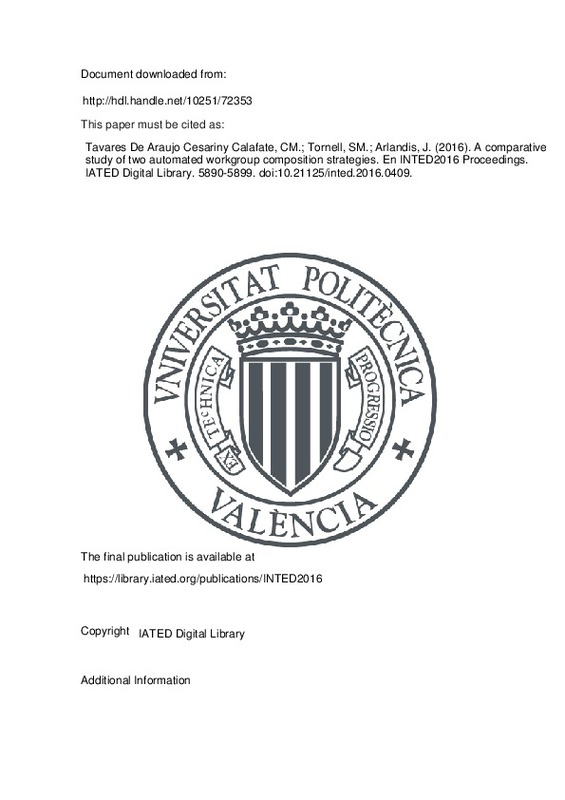JavaScript is disabled for your browser. Some features of this site may not work without it.
Buscar en RiuNet
Listar
Mi cuenta
Estadísticas
Ayuda RiuNet
Admin. UPV
A comparative study of two automated workgroup composition strategies
Mostrar el registro sencillo del ítem
Ficheros en el ítem
| dc.contributor.author | Tavares de Araujo Cesariny Calafate, Carlos Miguel
|
es_ES |
| dc.contributor.author | Tornell, Sergio M.
|
es_ES |
| dc.contributor.author | Arlandis, Joaquim
|
es_ES |
| dc.date.accessioned | 2016-10-20T07:27:48Z | |
| dc.date.available | 2016-10-20T07:27:48Z | |
| dc.date.issued | 2016-03-07 | |
| dc.identifier.isbn | 978-84-608-5617-7 | |
| dc.identifier.issn | 2340-1079 | |
| dc.identifier.uri | http://hdl.handle.net/10251/72353 | |
| dc.description.abstract | [EN] Nowadays, the professional environment of leading companies requires multidisciplinary teams to be created, including both internal and external experts, to adequately face the challenges of a fast-evolving and complex market. For newcomers, this situation can be difficult to handle if no previous experiences allowed preparing them for those situations. This is where college education finds its place, and in fact the curricula of different university careers are being updated to include more transversal competences like leadership and cooperation skills within groups. However, such efforts still remain at an amateur level in most cases due to lack of specific expertise by the majority of instructors, due to limitations in terms of creating actual multidisciplinary groups, and due to the little resources available to maximize the benefits of such experiences. Students also show little involvement in this issue, typically opting for approaches that minimize their efforts. Thus, simple and yet effective strategies that can be helpful for instructors to make a meaningful change to the current status quo are necessary. To address this need, in this paper we present the results of a 2-year study where students were forced to team up with other partners based on the results of a computer networking skills-ranking exam. In the first experiment, groups where formed by students achieving a similar performance (homogeneous), while in the second experiment groups were formed so that the average score of group members was the same (mostly heterogeneous). Through detailed survey results taken by students at the end of both courses, we find that, compared to an alternative group assignment strategy promoting group heterogeneity, having partners with similar skills does not help at improving the coordination between group members nor students perception about the usefulness of the experience towards future jobs. In fact, their rating of the overall experience was mostly the same, and, to our surprise, the partner expertise on the course topics was not a motivating factor, being that students complaints were always about not being able to decide about their partner. Thus, we consider that a simple strategy to define groups (e.g. randomly) suffices, but it should be adopted on all courses since the first year of the degree. | es_ES |
| dc.format.extent | 10 | es_ES |
| dc.language | Inglés | es_ES |
| dc.publisher | IATED Digital Library | es_ES |
| dc.relation.ispartof | INTED2016 Proceedings | es_ES |
| dc.rights | Reserva de todos los derechos | es_ES |
| dc.subject | Working group | es_ES |
| dc.subject | Classroom experiment | es_ES |
| dc.subject | Survey | es_ES |
| dc.subject | Automated partner assignment | es_ES |
| dc.subject.classification | ARQUITECTURA Y TECNOLOGIA DE COMPUTADORES | es_ES |
| dc.title | A comparative study of two automated workgroup composition strategies | es_ES |
| dc.type | Capítulo de libro | es_ES |
| dc.type | Comunicación en congreso | es_ES |
| dc.identifier.doi | 10.21125/inted.2016.0409 | |
| dc.rights.accessRights | Abierto | es_ES |
| dc.contributor.affiliation | Universitat Politècnica de València. Departamento de Informática de Sistemas y Computadores - Departament d'Informàtica de Sistemes i Computadors | es_ES |
| dc.contributor.affiliation | Universitat Politècnica de València. Escola Tècnica Superior d'Enginyeria Informàtica | es_ES |
| dc.contributor.affiliation | Universitat Politècnica de València. Escuela Técnica Superior de Ingeniería del Diseño - Escola Tècnica Superior d'Enginyeria del Disseny | es_ES |
| dc.description.bibliographicCitation | Tavares De Araujo Cesariny Calafate, CM.; Tornell, SM.; Arlandis, J. (2016). A comparative study of two automated workgroup composition strategies. En INTED2016 Proceedings. IATED Digital Library. 5890-5899. doi:10.21125/inted.2016.0409 | es_ES |
| dc.description.accrualMethod | S | es_ES |
| dc.relation.conferencename | 10th International Technology, Education and Development Conference (INTED 2016) | es_ES |
| dc.relation.conferencedate | March 7-9, 2016 | es_ES |
| dc.relation.conferenceplace | Valencia, Spain | es_ES |
| dc.relation.publisherversion | http://doi.org/10.21125/inted.2016.0409 | es_ES |
| dc.description.upvformatpinicio | 5890 | es_ES |
| dc.description.upvformatpfin | 5899 | es_ES |
| dc.type.version | info:eu-repo/semantics/publishedVersion | es_ES |
| dc.relation.senia | 317866 | es_ES |







![[Cerrado]](/themes/UPV/images/candado.png)

